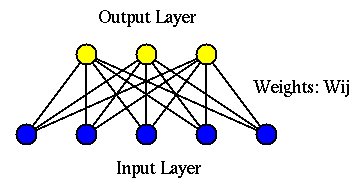Next: Hopfield Network Up: ch10 Previous: Biological and Artificial Neural
Donald Hebb (1949) speculated that “When neuron A repeatedly and persistently takes part in exciting neuron B, the synaptic connection from A to B will be strengthened.” In other words, simultaneous activation of neurons leads to pronounced increases in synaptic strength between them, or “neurons that fire together wire together; neurons that fire out of sync, fail to link".
For example, the well known classical conditioning (Pavlov, 1927) could be explained by Hebbian learning. Consider the following three patterns (see here):
 . Due to the
repeated and persistent conditioning process
. Due to the
repeated and persistent conditioning process
 ,
the synaptic connections between patterns B and S are strengthened as
both are repeatedly excited simultaneously, i.e., the two patterns
become associated, resulting the conditioned response
,
the synaptic connections between patterns B and S are strengthened as
both are repeatedly excited simultaneously, i.e., the two patterns
become associated, resulting the conditioned response
 .
.
Based on this theory of Hebbian learning, the Hebbian network
can be considered as a supervised learning method that learns to
establish the associative relationship between any pair of two
patterns 




![${\bf x}=[x_1,\cdots,x_d]^T$](img44.svg)

![${\bf y}=[y_1,\cdots,y_m]^T$](img46.svg)

 |
(11) |
![${\bf w}_i=[w_{i1},\cdots,w_{id}]^T$](img48.svg) , or in matrix form
, or in matrix form
![$\displaystyle {\bf y}=\left[\begin{array}{c}y_1\\ \vdots\\ y_m\end{array}\right...
...ght]
\left[\begin{array}{c}x_1\\ \vdots\\ x_d\end{array}\right]
={\bf W}{\bf x}$](img49.svg) |
(12) |
![${\bf W}=[{\bf w}_1,\cdots,{\bf w}_m]^T$](img50.svg) is an
is an  matrix.
matrix.

The Hebbian learning rule is inspired by Hebb's theory, i.e.,
when both neurons 


 |
(13) |
 |
(14) |
 is the learning rate, a parameter that controls
how quickly the weights get modified.
is the learning rate, a parameter that controls
how quickly the weights get modified.
As in all supervised learning, the Hebbian network is first trained and then used for association.
For simplicity, we assume all weights are initialized to zero



 |
(15) |
 pairs of patterns:
pairs of patterns:
![$\displaystyle {\bf W}_{m\times d}=\sum_{n=1}^N {\bf y}_n {\bf x}_n^T = \sum_{n=...
...n)} \\ \vdots \\ y_m^{(n)} \end{array} \right]
[ x_1^{(n)}, \cdots, x_d^{(n)} ]$](img60.svg) |
(16) |
When one of the patterns 
 |
(17) |
 , under the following conditions:
, under the following conditions:
 patterns
patterns
 are
treated as zero-mean random vectors, and they are assumed to be
completely uncorrelated with zero correlation coefficient
between any
are
treated as zero-mean random vectors, and they are assumed to be
completely uncorrelated with zero correlation coefficient
between any  and
and  :
:
 |
(18) |
 , then we have
, then we have

 , i.e., the capacity of the network is large enough
for representing
, i.e., the capacity of the network is large enough
for representing  different patterns (as there can be no more than
different patterns (as there can be no more than
 orthogonal vectors in a d-dimensional space).
orthogonal vectors in a d-dimensional space).
Under these conditions, the output of the network as its response
to input 
 |
(19) |
 for all other terms with
for all other terms with  .
We see that a one-to-one correspondence relationship between
.
We see that a one-to-one correspondence relationship between
 and
and  has been established for all
has been established for all
 . In non-ideal cases when the conditions above are
not fully satisfied, the summation term is non-zero and there is
an error
. In non-ideal cases when the conditions above are
not fully satisfied, the summation term is non-zero and there is
an error
 .
.